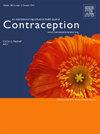PHARMACIST-PRESCRIBED MEDICATION ABORTION: A QUALITATIVE EXPLORATION IN MASSACHUSETTS
IF 2.3
2区 医学
Q1 OBSTETRICS & GYNECOLOGY
引用次数: 0
Abstract
Objectives
Efforts to increase access to medication abortion in the US are urgently needed. We gathered the perspectives of key partners in Massachusetts to explore expanding medication abortion access through a pharmacist-prescribed care model.
Methods
Between January and October 2024, we conducted 31 interviews with patients, pharmacists, policymakers, clinicians, and advocates in Massachusetts. Interviews explored views on pharmacy-based medication abortion access, key patient support needed, and the barriers and facilitators to implementation. Interviews were analyzed thematically using MAXQDA.
Results
Participants were largely supportive of the model, indicating that pharmacist-prescribed medication abortion could improve access, particularly for communities who face barriers, including young people, unhoused individuals, and those in rural settings or with limited transport. Other benefits included faster access to care compared to in-clinic or telemedicine models. However, a variety of challenges were raised, including a lack of confidential counseling spaces, concerns around reimbursement for pharmacists’ services, and limited staff time and resources. Key factors for successful implementation were thought to include comprehensive follow-up care, enhanced privacy in pharmacies, affordable pharmacist training, insurance coverage of patient care and pharmacist counseling, and coalitions comprising community organizations and abortion providers.
Conclusions
Our findings contribute to the growing body of literature showing the potential benefits of expanding pharmacists’ role in abortion care in the US and highlights the importance of addressing structural and financial challenges for successful implementation and expansion of abortion care.
药剂师处方流产:马萨诸塞州的定性探索
目的提高美国药物流产的可及性是迫切需要的。我们收集了马萨诸塞州主要合作伙伴的观点,探索通过药剂师处方护理模式扩大药物流产的准入。方法在2024年1月至10月期间,我们对马萨诸塞州的患者、药剂师、政策制定者、临床医生和倡导者进行了31次访谈。访谈探讨了对基于药物的药物流产获取,关键患者支持需求,以及实施的障碍和促进因素的看法。使用MAXQDA对访谈进行主题分析。结果大部分参与者都支持该模式,表明药剂师处方药物流产可以改善获取,特别是对于面临障碍的社区,包括年轻人,无家可归的人,以及农村环境或交通有限的人。其他好处包括与诊所或远程医疗模式相比,更快地获得护理。然而,提出了各种各样的挑战,包括缺乏保密的咨询空间,对药剂师服务报销的担忧,以及有限的工作人员时间和资源。成功实施的关键因素被认为包括全面的后续护理、加强药房的隐私、负担得起的药剂师培训、病人护理和药剂师咨询的保险范围以及由社区组织和堕胎提供者组成的联盟。结论我们的研究结果有助于越来越多的文献显示扩大药剂师在美国堕胎护理中的作用的潜在好处,并强调解决结构性和财政挑战对成功实施和扩大堕胎护理的重要性。
本文章由计算机程序翻译,如有差异,请以英文原文为准。
求助全文
约1分钟内获得全文
求助全文
来源期刊

Contraception
医学-妇产科学
CiteScore
4.70
自引率
17.20%
发文量
211
审稿时长
69 days
期刊介绍:
Contraception has an open access mirror journal Contraception: X, sharing the same aims and scope, editorial team, submission system and rigorous peer review.
The journal Contraception wishes to advance reproductive health through the rapid publication of the best and most interesting new scholarship regarding contraception and related fields such as abortion. The journal welcomes manuscripts from investigators working in the laboratory, clinical and social sciences, as well as public health and health professions education.
 求助内容:
求助内容: 应助结果提醒方式:
应助结果提醒方式:


